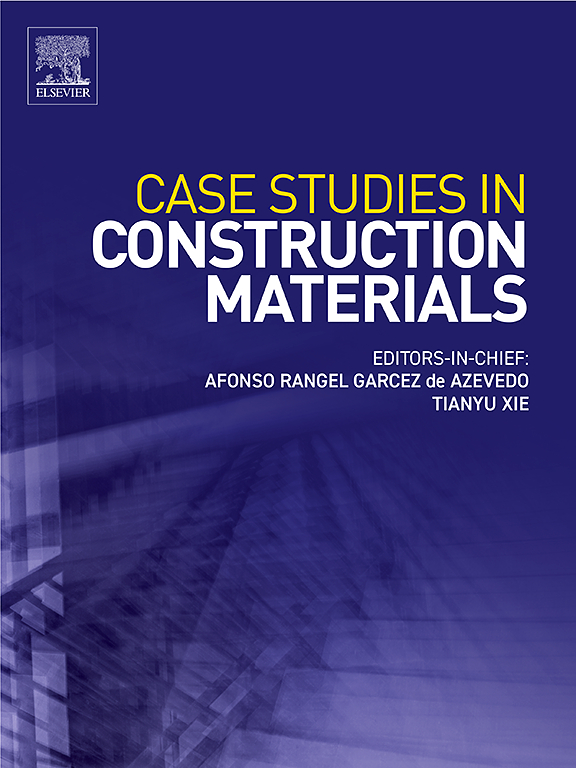循环荷载作用下钢纤维增强全再生粗/细骨料混凝土的应力-应变关系
IF 6.5
2区 工程技术
Q1 CONSTRUCTION & BUILDING TECHNOLOGY
引用次数: 0
摘要
本研究考察了再生混凝土在各种再生材料混合体系和不同钢纤维(SF)体积含量下的应力-应变行为。进行了单轴循环加载试验,以评估破坏模式、应力-应变曲线、轴向抗压强度和残余应变。结果表明:再生材料的掺入使破坏模式由垂直劈裂转变为斜剪,降低了应力-应变曲线的上升斜率和轴向抗压强度;具体来说,与天然混凝土相比,全再生骨料混凝土的强度降低幅度最大,为26.27 %,与全再生细骨料混凝土(FRFAC)相比,强度仅降低2.4 %。SF的加入显著提高了再生混凝土的循环抗压性和延性,增加了循环次数和最大累积残余应变。当纤维含量为1.5 %时,FRFAC循环次数比对照增加了20次,最大累积残余应变由0.86增加到10.38。通过引入再生材料系数和SF特征参数,描述了残余应变与卸载/加载应变之间的关系。根据试验数据,提出了卸载和再加载方程,并在刚度退化的基础上提出了包含残余应变的损伤演化方程。建立了SF加筋全再生粗/细骨料混凝土的本构模型,能够表征不同再生材料和SF掺量对混凝土的影响。该模型准确地预测了卸载/再加载路径、残余应变进展和损伤演变。本文章由计算机程序翻译,如有差异,请以英文原文为准。
Stress-strain relationship of steel fiber reinforced fully recycled coarse/fine aggregate concrete under cyclic loading
This study examines the stress-strain behavior of recycled concrete subjected to various recycled material mixture systems and varying steel fiber (SF) volume contents. Uniaxial cyclic loading tests were conducted to assess the failure modes, stress-strain curves, axial compressive strength, and residual strains. The findings indicate that incorporating recycled materials shift the failure mode from vertical splitting to oblique shear and reduces the stress-strain curve's ascending slopes and axial compressive strength. Specifically, the strength of fully recycled aggregate concrete experienced the greatest reduction of 26.27 % relative to natural concrete, and only a 2.4 % reduction compared to fully recycled fine aggregate concrete (FRFAC). The inclusion of SF significantly enhances the cyclic compression resistance and ductility of recycled concrete, increasing both the cycle count and the maximum cumulative residual strain. At a fiber content of 1.5 %, FRFAC's cycle count increased by 20 compared to the control, and the maximum cumulative residual strain rose from 0.86 to 10.38. The relationship between residual strain and unloaded/reloaded strain is described by introducing recycled material coefficient and SF characteristic parameter. Based on the test data, the unloading and reloading equations proposed, and the damage evolution equation including residual strain proposed on the basis of stiffness degradation. A constitutive model for SF reinforced fully recycled coarse/fine aggregate concrete is developed, capable of characterizing the effects of different recycled materials and SF content. This model accurately predicts the unloading/reloading path, residual strain progression, and damage evolution.
求助全文
通过发布文献求助,成功后即可免费获取论文全文。
去求助
来源期刊

Case Studies in Construction Materials
Multiple-
CiteScore
7.60
自引率
19.40%
发文量
842
审稿时长
63 days
期刊介绍:
Case Studies in Construction Materials provides a forum for the rapid publication of short, structured Case Studies on construction materials. In addition, the journal also publishes related Short Communications, Full length research article and Comprehensive review papers (by invitation).
The journal will provide an essential compendium of case studies for practicing engineers, designers, researchers and other practitioners who are interested in all aspects construction materials. The journal will publish new and novel case studies, but will also provide a forum for the publication of high quality descriptions of classic construction material problems and solutions.
 求助内容:
求助内容: 应助结果提醒方式:
应助结果提醒方式:


